All you need to know about your products!

| 3DNews Vendor Reference English Resource - All you need to know about your products! |
||||||
 |
||||||
|
|
||||||
Gigabyte GeForce PCX 5900 Video Card ReviewAuthor:Date: 04/08/2004 Introduction
The first half of 2004 for NVIDIA turned out to be definitely successful. All started with the presentation of the new series of NV4х (GeForce 6 Series) graphic processors where NVIDIA virtually shattered the whole IT industry and shocked the reviewers by the outstanding potentials and truly revolutionary novelties in the graphic processor architecture and its specifications. That immediately gained confirmation in practice. That was a really tremendous gap between the previous-generation high-end solutions, impressive performance virtually everywhere - in the synthetics, which fans of benchmarking took immediate advantages, at gaming applications which made gamers seriously think of the budget of the next year on the matter of buying such a tempting product. Of course, high-end solutions, however attractive they looked, have always had and will have an outstanding price. That is quite logical and justified. But what to do if "you want to have it, but can't afford"? And there it goes! Some time after the first presentation where GeForce 6800Ultra and GeForce 6800 were presented, NVIDIA releases GeForce 6800GT, a solution with the nominal frequencies downstated relative to 6800Ultra, 16 pipelines and, thus, considerably reduced price. That changed the alignment of forces completely, and while formerly X800 PRO had been confident at surpassing GeForce 6800 non Ultra, then it came up against a more serious rival - 6800GT, so NVIDIA made an extremely successful marketing move and brought a big gift to the consumers. Now regarding those gifts from NVIDIA. This suggests the analogy - some time before that the release of video cards on the GeForce FX5900 XT chip made on the NV35 graphic chip proved a gift as well. The board offered a PCB design simplified relative to FX5900, 128 MB of video memory and reduced frequencies. The release of boards proved to be truly a hit in the respective pricing sector of the market and a favorite product of overclockers. That is already a thing of the past. But the progress does not stand still. Soon PCI-Express solutions will flood the market, and the consumer will stop treating the HSI bridge like a strange and rare novelty. "Regulars" at hardware conferences will instruct freshers and argue with each other as to which is better - MSI or Abit, Gigabyte or Leadtek - bringing in irrefutable evidence like "I was able to overclock it to ***/*** ". But for now our task is to describe it to the full what will be installed in your computer in a few months/half a year/a year. Today, we are presenting GeForce PCX5900, the PCI-Express "reincarnation" of the NV35 chip (GeForce FX5900) equipped with the AGP - PCI-Express bridge. 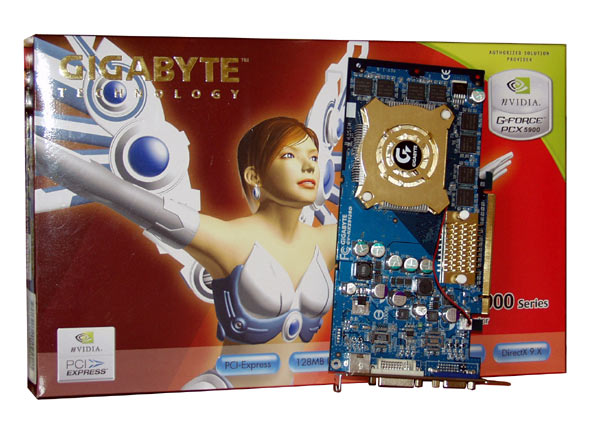
You have already come across the two of them - MSI GeForce PCX5750 and MSI RX600XT - in our previous review, and GeCube RX600 PRO, most interesting in all the respects, will be presented to you in one of the forthcoming materials. Now let's move on to examining the PCX5900. Package bundle The package bundle contains all the most needed, plus some additional "nice trifles".

Design and layout You can judge about a person by the way he/she walks, but Gigabyte stands out with its customary blue color of textolyte. At that, Gigabyte is consistent. The manufacturer of a given video card can be told apart even without looking at the box - a quick look at the board would suffice. 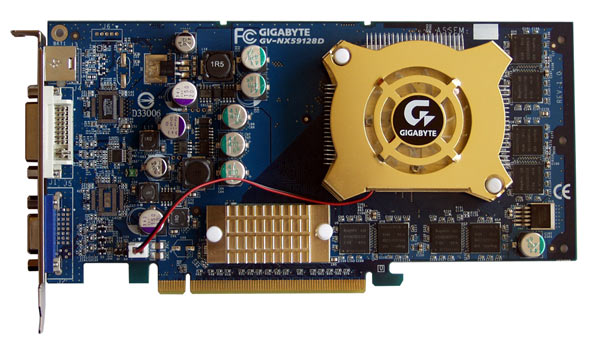 *1200x705; 177kb 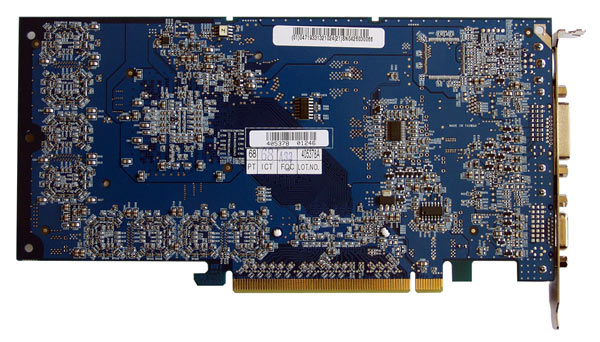 *1200x683; 286kb There is 128 Mb DDR memory onboard with the 256-bit data transfer bus made as eight Hynix memory chips marked HY5DU283222AF-28, in the BGA packaging, 2.8 ns access time, which is equivalent to 350 MHz (700 MHz DDR) operating frequency. But on this particular specimen the rated operating frequency of the video memory proved to be a bit downstated to 275 MHz (550 MHz DDR). Anyway, it is really curious to take a look at the overclocking potential of memory on the board. 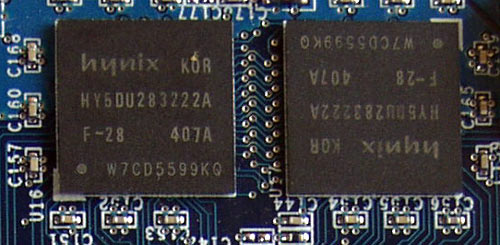
All the eight video memory chips are positioned over the front side of the board without any cooling. Now, let's turn to the most important. The graphic processor. Let me put it straight - it was not easy at all to get to it. When on earth will the manufacturers consider the requests and wishes (or even prayers) from the part of consumers/reviewers/etc and cease using that "thermal chewing gum" for the thermal interface? And even this time again, with "ritual witchcraft" we finally succeeded in detaching the radiator (whose design specifics will be covered a bit later) off the video card chip. Our efforts were not in vain and we saw the GPU in its beauty. 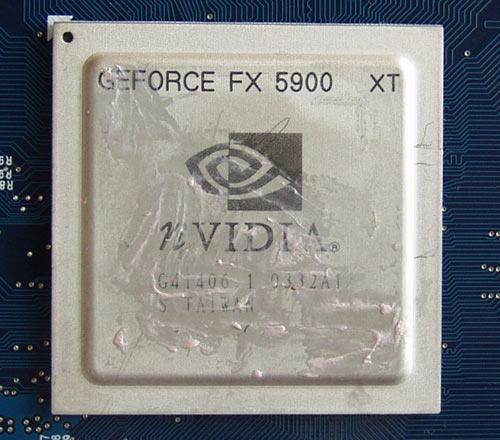
That done, we experience a real astonishment. In the right-hand corner of the lid that cover the chip we found the "XT" caption. A GeForce FX 5900XT chip, isn't it? Yes, the very favorite of the middle-end sector of the market of the past round, which we mentioned above. A very interesting aftergrowth, isn't it? Has NVIDIA really decided to revive 5900XT in the PCI-Express make? Regarding the GPU, I have to add that was made on the 32nd week of 2003 and is of revision A1, as we can see from the marking. The rated operating frequency of the GPU is 350 MHz. At last, we got to the cooling system. Gigabyte provided cooling for the graphic core in the form of an aluminum radiator with the corporate logo put straight over the center of the component. Looking at the cooling system, you immediately recall GeForce FX5900 ХТ made by Gigabyte. These two boards offer absolutely identical design of the cooling system, with the only difference in reduced size because on 5900XT a massive radiator covered the GPU as well, and the memory chips positioned in absolutely the same way as in PCX5900 in question. 
On this board, no additional cooling is provided, which has been long regarded as a no-flaw since the users who are into upgrading the hardware would not care much of additional cooling. Overclockers and PC enthusiasts will treat any standard cooling as insufficient for their purposes. Modders would rather prefer installing radiators of their own "make" and design. It's good that nowadays a huge assortment of radiators to any taste and color is available. At the same time, processor radiators can be easily modified and fitted on the video memory chips, provided you are a handicraftsman enough to put it all right with the respective tools. At that, we stop our lyrical digression on the topic of radiators and turn back to the hero of today's review. The next significant part is the HSI bridge. A radiator is also fitted on it. 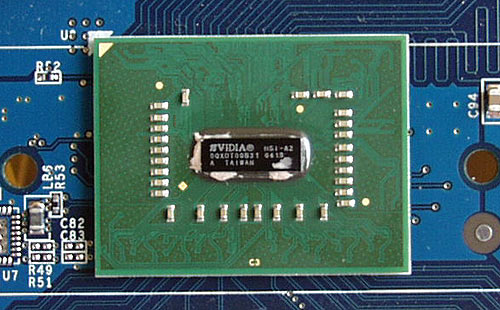
The board offers a standard set of outputs: analogous, digital, and S-Video. 
I can imagine how your curiosity has reached the apogee by now. OK, let's not torment you any more. Here are the results. Test configurationFor tests, we used our own test configuration known to you from our previous reviews.
Test software:
Here is the testing procedure. Let's first look at the synthetic results: 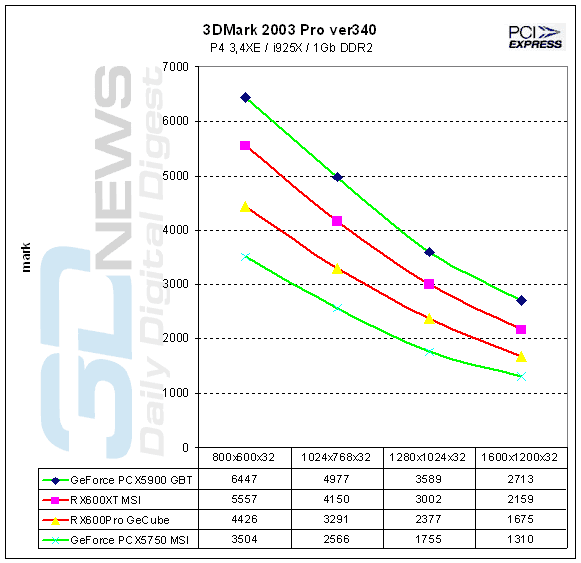

Well what do we see now? At Futuremark's benchmarks, so popular and adored among the "benchers' community", PCX5900 takes a sure lead over the rivals and wins at all the tests in all the resolutions. 
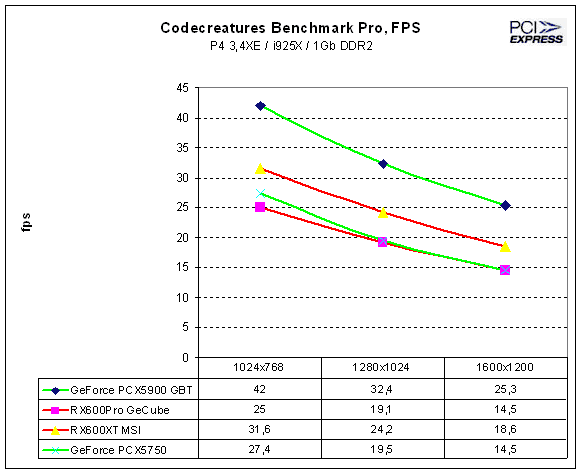

Here we observe an absolutely similar situation. And now let's see what the gaming applications will show. Tests of gaming applications

РСХ5900 continues its triumphant leadership, with Х600ХТ going very closely behind, which we described in the previous review. 
Here is the first failure. X600XT leaves the competitors behind, but РСХ5900 already has to struggle with X600 PRO which, as you remember, offers frequencies downstated relative to those in Х600ХТ. 

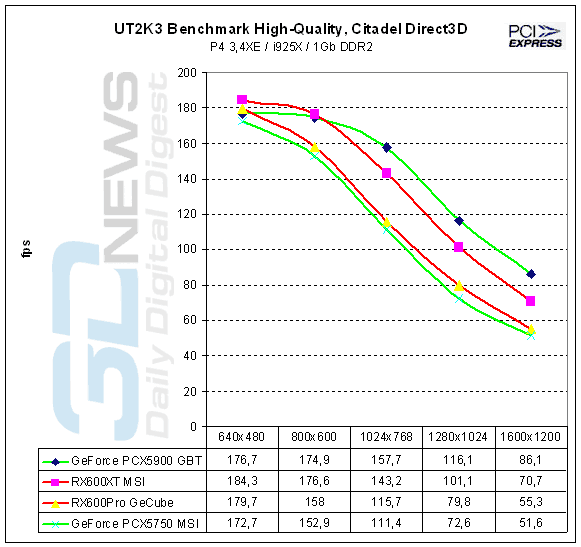


The advantages of РСХ5900 make themselves felt in UT either, but it would not be correct to claim a complete victory. Х600ХТ practically does not lag behind and sometimes even surpasses PCX5900. 
At HALO, PCX5900 is again a leader. 
That is contrary to the Half Life2 demo. Anyway, its results should not be regarded as the ultimate truth. 
But the failure at Tomb Rider is already a more serious blunder. 
Here PCX5900 goes on par with X600XT, leaving Х600 PRO and РСХ5750 well behind. In fact, the latter traditionally brings up the rear, so we could have ignored it at all. 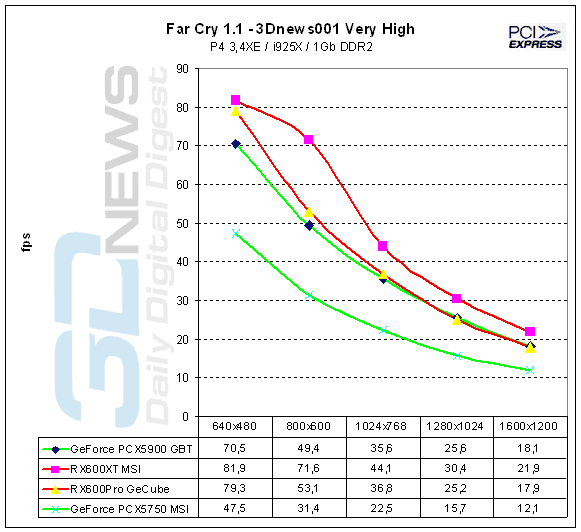

At Far Cry, X600XT again surpasses РСХ5900, however at higher resolutions the gap shrinks a bit.
|
||||||||||||||||||||||||||||||
|
|||||